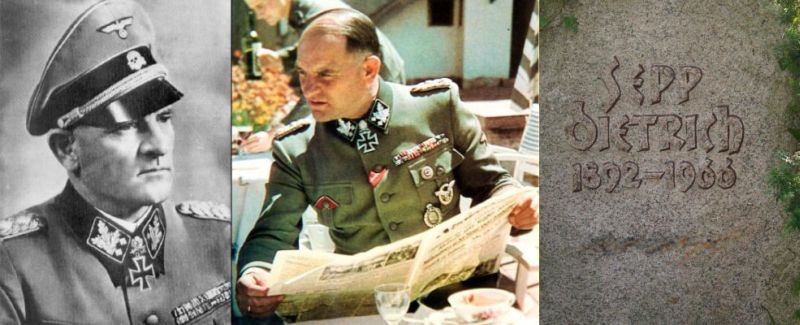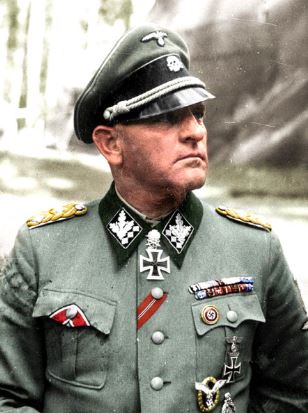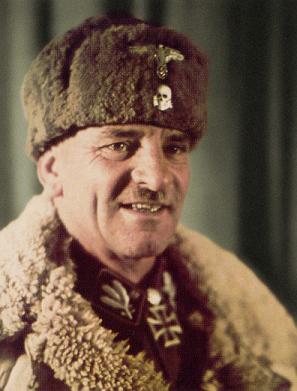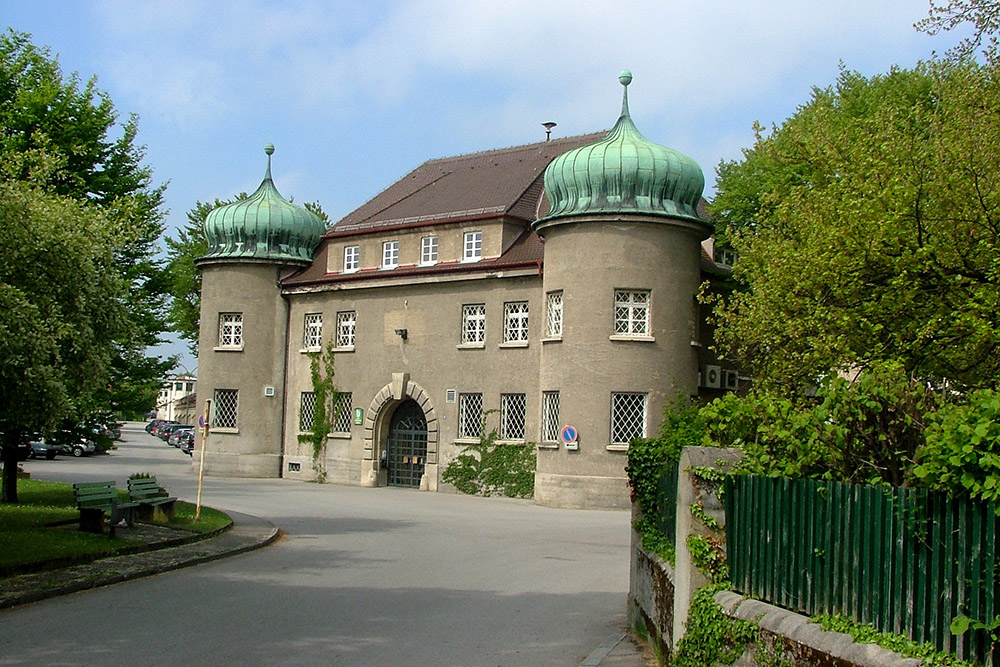Dietrich, Josef 'Sepp' (Waffen SS)
- Date of birth:
- May 28th, 1892 (Hawangen, Bavaria, German Empire)
- Date of death:
- April 21st, 1966 (Ludwigsburg, Germany)
- Service number:
- SS-Nr.: 1.117 // NSDAP-Nr.: 89.015
- Nationality:
- German
Biography
Josef -Sepp- Dietrich was born May 28th, 1892, in Hawangen, Bavaria, Germany. He started his military career in the Bavarian army. During World War 1 he served as a gunner and was injured several times. After WW 1 he joined the Bavarian State Police. In 1928 he joined the NSDAP (National-Socialist Workers Party) where he came to know Hitler personally. His agressive spirit was highly appreciated and he became Hitler's personal bodyguard. Once Hitler had assumed power in 1933, Dietrich established Hitler's personal guard detail, a unit that would later be known as the Leibstandarte Adolf Hitler and became part of the Waffen-SS, the military section of the SS. Its original complement of 120 men increased during the course of the war to that of an armoured division. Dietrich, together with Hitler and six other men, was involved in the arrest and subsequent liquidation of Ernst Röhm, at the time the head of the SA (Sturm Abteilung)and Hitler's Chief of Staff, in what later became known as the Night of the Long Knives on June 30th, 1934, in Bad Wiessee.
During the Polish campaign, the Leibstandarte saw action for the first time as part of the Panzerdivision (Armoured division) Kemp. The unit committed the first warcrime before the war had even begun: in a synagogue, 50 Jews were murdered.
In the battle for Lodz, the Leibstandarte was deployed as an independant unit for the first time and later in Warsaw. Hitler took a keen interest in Dietrich's battle actions. When Germany invaded France and the Low Countries in 1940, the Leibstandarte, commanded by Dietrich pushed head-on through the Netherlands; the unit also participated in the encirclement of Dunkirque. Once again, the unit was involved in warcrimes by murdering 80 British POW's. Dietrich later maintained not to have been present nor to have given the order for the massacre. After the battle for France, Dietrich was awarded the Ritterkreuz (Knight's Cross). In April 1941, the unit participated in the invasion of Yugoslavia and Greece.
At the start of Operation Barbarossa, Germany's invasion of the Soviet Union, the Leibstandarte was assigned to Heeresgruppe Süd (Armygroup South). During an offensive action, six mutilated bodies of SS soldiers were discovered by the unit. Dietrich ordered all Russian POW's to be shot in reprisal for three days; the number of victims was estimated to be 4.000.
In December 1942, he was awarded the Eichenlaub zum Ritterkreuz (Oak Leaves to the Knight's Cross). That year, the Leibstandarte was stationed in France for rest and refit after the battles on the Eastern front. In the spring of 1943, Dietrich's division took part in the brilliant recapture of the Russian city of Charkow and again, the Leibstandarte commanded by Dietrich committed warcrimes by murdering 700 Russian POW's. For his achievements, Dietrich was awarded the Schwerten zum Ritterkreuz (Swords to the Knight's Cross). He then left the Leibstandarte temporarily for a period of rest and recuperation.
June 1944, saw Dietrich promoted to commander of the 1 SS Panzerdivision (SS Armoured division) that was stationed in France. During the Allied invasion in Normandy, the Leibstandarte did not succeed in driving the Allies back into the sea but they did prevent an Allied breakout for three weeks. Afterwards, Dietrich was promoted to SS-Oberstgruppenführer (SS General) and Generaloberst der Waffen-SS (approx. Commander in Chief), after Reichsführer-SS Heinrich Himmler, the highest rank in the Waffen-SS. He was awarded the Brillianten zum Ritterkreuz (Diamonds to the Knight's Cross).
In November 1944, Dietrich was given command of 6 Panzerarmee (Tank Army). During Operation Wacht am Rhein, the Ardennes offensive, Dietrich's divisions encountered fierce resistance by the Americans who managed to prevent Dietrich from breaking through. Once again, the SS was involved in warcrimes: near the Belgian town of Malmédy, 100 American POW's were butchered.
After the failure of the Ardennes offensive, Dietrich was ordered to lead the last German offensive of the war: the capture of the oilfields near Budapest but in this, he failed.
In the wake of the armistice in May 1945, Dietrich and his wife surrendered to the American general Patton. Dietrich was imprisoned and brought before the Neurenburg wartribunal in 1946. He was charged with various warcrimes and sentenced to 25 years imprisonment.
After haveng been released prematurely from the Landsberg prison in 1955, he was indicted again for his participation in the Night of the Long Knives in 1934 and sentenced to another year and a half imprisonment.
Josef Dietrich died in Ludwigsburg, Germany on April 21st, 1966 at the age of 74.
Do you have more information about this person? Inform us!
- Period:
- First World War (1914-1918)
- Rank:
- Vizewachtmeister
- Awarded on:
- November 14th, 1917
- Period:
- First World War (1914-1918)
- Rank:
- Vizewachtmeister
- Unit:
- bayerischen Sturmpanzerwagen-Abteilung 13
- Awarded on:
- June 1918
- Period:
- First World War (1914-1918)
- Period:
- First World War (1914-1918)
- Period:
- First World War (1914-1918)
- Rank:
- Polizei-Wachtmeister
- Awarded on:
- 1921
- Period:
- First World War (1914-1918)
- Rank:
- SS-Gruppenführer (Lieutenant General)
- Awarded on:
- 1934
- Rank:
- SS-Obergruppenführer (General)
- Awarded on:
- 1936
- Period:
- Second World War (1939-1945)
- Rank:
- SS-Obergruppenführer (General)
- Unit:
- Kommandeur, Infanterie Regiment (mot.) "Leibstandarte SS Adolf Hitler"
- Awarded on:
- September 25th, 1939
- Period:
- Second World War (1939-1945)
- Rank:
- SS-Obergruppenführer (General)
- Unit:
- Kommandeur, Infanterie Regiment (mot.) "Leibstandarte SS Adolf Hitler"
- Awarded on:
- October 27th, 1939
- Period:
- Second World War (1939-1945)
- Rank:
- SS-Obergruppenführer (General)
- Unit:
- Kommandeur Infanterie Regiment (motorisiert) "Leibstandarte SS Adolf Hitler"
- Awarded on:
- July 4th, 1940
“SS-Obergruppenführer Sepp Dietrich has decisively influenced the fighting in his sector through his independent initiative. By securing a bridgehead over the Aa canal at Watten (26.05.1940) he enabled a swift continuation of operations in the direction of Wormhout. More than that he particularly distinguished himself through his personal bravery and sincere comradely cooperation with the armoured and motorized formations of the Heer, just as in Poland.”
- Period:
- Second World War (1939-1945)
- Rank:
- SS-Obergruppenführer / General der Waffen-SS (General)
- Unit:
- Kommandeur, SS-Division (motorisiert) "Leibstandarte SS Adolf Hitler"
- Awarded on:
- December 31st, 1941
“For his outstanding offensive achievements during the battle at the Sea of Azov and the capture of Rostov.”
41st Award.
- Period:
- Second World War (1939-1945)
- Rank:
- SS-Oberst-Gruppenführer (Colonel General)
- Awarded on:
- July 16th, 1942
- Period:
- Second World War (1939-1945)
- Awarded on:
- 1942
- Period:
- Second World War (1939-1945)
- Rank:
- SS-Oberst-Gruppenführer (Colonel General)
- Awarded on:
- 1942
- Period:
- Second World War (1939-1945)
- Awarded on:
- 1943
- Period:
- Second World War (1939-1945)
- Rank:
- ehrenhalber
- Period:
- Second World War (1939-1945)
- Period:
- Second World War (1939-1945)
- Rank:
- SS-Oberst-Gruppenführer (Colonel General)
- Unit:
- Kdr, SS-Panzer-Grenadier-Division "Leibstandarte SS Adolf Hitler"
- Awarded on:
- March 14th, 1943
“The Swords for Obergruppenführer Sepp Dietrich - How the Leibstandarte captured Kharkov:
Following days of heavy fighting the divisions of the SS-Panzerkorps retook the city of Kharkov in a deliberate attack from the north and east. The SS-Panzergrenadier-Division ‘Leibstandarte Adolf Hitler’ under the command of SS-Obergruppenführer und General der Waffen-SS Sepp Dietrich had an outstanding share in this great success by our troops. Yesterday evening it was announced that Sepp Dietrich had been awarded the Oakleaves with Swords to the Knight’s Cross of the Iron Cross. This is a sign of the thanks and recognition that the Führer has for the brave men of his unit and their commander, the conquerer of Kharkov.
The Leibstandarte opened the attack against Kharkov (which had by then been created into a veritable fortress by the Soviets) on the 10.03.1943, attacking from the north in the early morning hours with several assault columns. The SS men slowly gained ground in a bitter struggle against the tough and bitterly defending enemy. Following heavy urban combat they succeeded in achieving the first big penetration into the Soviet positions, which enabled them to thrust up to the city centre. The Red Square, the symbol of Soviet domination, as well as the central train station were taken by storm.
The defending Soviet forces fought with furious defensive fire from the wrecked walls and piles of rubble within the city. However they were ultimately smoked out street by street, block by block, factory by factory. At the same time other formations of the Waffen-SS entered into the city from the west and east. On the 13.03.1943, following the destruction of additional enemy battlegroups, contact between the elements of the Leibstandarte coming from the north and the units of the SS-Division ‘Reich’ fighting in the western part of the city was established. The last bitter Soviet resistance was offered in the southeastern part of the city, however this was ultimately crushed on the evening of the 14.03.1943. By 18:50 this industrial metropolis of the eastern Ukraine, temporarily occupied by the enemy since the 17.02.1943, was fully in German hands.
Having been majorly involved in the recapture of Kharkov, the Leibstandarte SS Adolf Hitler can now add a glorious chapter to its proud history. In the operations that preceded this momentous success the Leibstandarte also outstandingly distinguished itself during the weeks of heavy combat between the Donez and Dnieper rivers. In this fighting the Leibstandarte was also to be found at the spearhead of our forces as the formations of the Heer and Waffen-SS managed to contain the onslaught of the enemy’s overwhelming winter offensive. The enemy was worn down with vigorous counterthrusts, and during all this time the stage was prepared for the recapture of the lost ground and the destruction of the Soviet shock armies, a success which culminated in the seizure of Kharkov itself.
Two new Oakleaves recipients (SS-Standartenführer Fritz Witt and SS-Obersturmbannführer Kurt Meyer) and six new Knight’s Cross Holders from the Leibstandarte testify to the exceptional devotion to duty of the SS men in these few weeks. But it is with the award of the Swords to its commander that the LSSAH finds its greatest and most valuable recognition. It is an honour that fills the heart of every single man with irrepressible pride.”
26th Award.
- Period:
- Second World War (1939-1945)
- Rank:
- SS-Oberst-Gruppenführer (Colonel General)
- Awarded on:
- 1943
- Period:
- Second World War (1939-1945)
- Rank:
- SS-Oberst-Gruppenführer (Colonel General)
- Unit:
- Kommandierender General I.SS-Panzer-Korps "Leibstandarte SS Adolf Hitler"
- Awarded on:
- August 6th, 1944
16th Award.
Sources
- Photo 1: Wilco Vermeer, Willi Schumacher Collection, Beyerlein sammlung
- Photo 2:
- - THOMAS, FRANZ & WEGMANN, GüNTER, Die Ritterkreuzträger der Deutschen Wehrmacht 1939-1945, Biblio Verlag, Osnabrück, 1998.
- Fellgiebel W.P., Elite of the Third Reich, The recipients of the Knight's Cross of the Iron Cross 1939-1945: A Reference, Helion & Company Limited, Solihull, 2003, ISBN 1-874622-46-9
- Yerger, M.C., Waffen-SS Commanders, Shiffer Publishing Ltd., U.S.A., 1997
- Schneider J.W., Their Honor was Loyalty!, R. James Bender Publishing, 1977
- Tixier, T, Allgemeine SS - Polizei - Waffen SS Volume 3 (2019)
- Royal Decree No. 2020/16 July 1942, Romania
- Feldgrau.com
- Axis Biographical Research










































